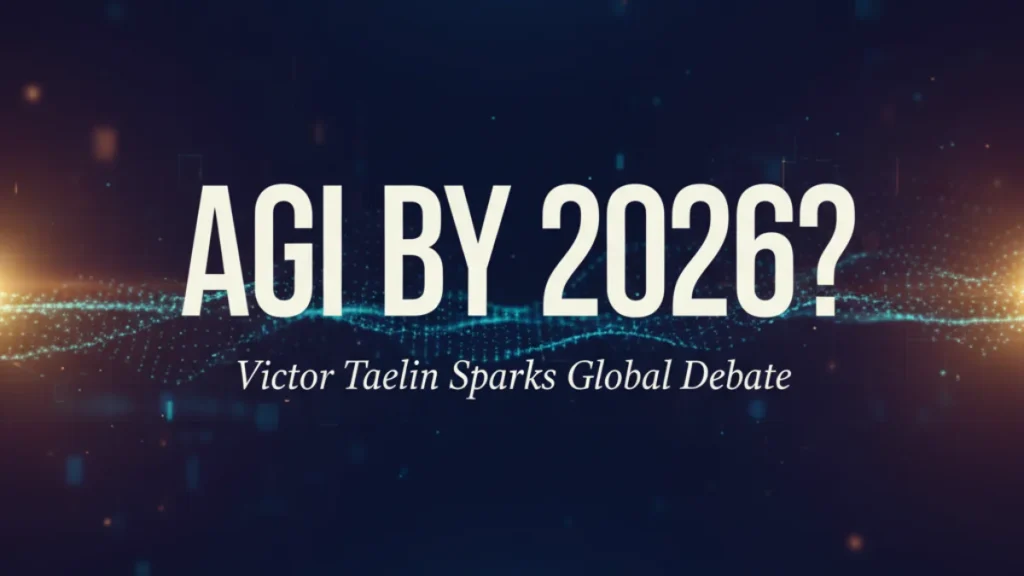Developer and AI commentator Victor Taelin shook the tech world today by boldly forecasting that artificial general intelligence (AGI) will emerge by 2026. The prediction comes at a moment when large-language models (LLMs) are facing mounting criticism for their reasoning failures — and the stakes are growing for technology, industry and society.
In the growing debate, prominent voices like Gary Marcus and Richard Sutton argue that we’re chasing a dead-end with current models, while optimists highlight near-term productivity gains even if AGI remains farther away.
Key Takeaways
- Victor Taelin publicly predicts AGI will arrive by 2026 — consider it “more likely than not.”
- A recent research paper by Apple Inc. shows LLMs struggle badly with out-of-distribution, high-complexity tasks.
- Gary Marcus says the LLM model is hitting “fundamental” limits and doubts pure scaling will yield AGI.
- Andrej Karpathy warns that AGI remains “a decade away” at minimum — highlighting major gaps in continual learning and multimodality.
- The divide is stark: some claim AGI soon, others say we must rebuild the foundations of intelligence.
Developer Victor Taelin predicts AGI will arrive by 2026, citing recent large-language-model (LLM) failures including reasoning collapse in complex tasks. Meanwhile AI critics like Gary Marcus and researcher Richard Sutton say pure neural LLMs are hitting a wall, and AGI may require hybrid symbolic-neural systems.
What Taelin Is Saying
Taelin’s tweet on 19 October 2025 asserted:
“AGI is coming in 2026, more likely than not — LLMs are big memorisation/interpolation machines, incapable of doing scientific discoveries and working…”
He explicitly called out LLMs for lacking scientific-discovery ability and warned that we must rethink our paths to AGI.
His stance is striking primarily because it contrasts with the prevailing caution in large parts of the AI research community.
(Low quality opinion post / feel free to skip)
— Taelin (@VictorTaelin) October 19, 2025
Now that AGI isn't cool anymore, I'd like to register the opposing position.
– AGI is coming in 2026, more likely than not
– LLMs are big memorization/interpolation machines, incapable of doing scientific discoveries and working…
The Cracks in the LLM Paradigm
A recent study by Apple researchers, titled The Illusion of Thinking, demonstrates that advanced “large reasoning models” break down when faced with high-complexity tasks — sometimes performing worse than simpler models.
Gary Marcus described the findings as “devastating” for the LLM-first AGI narrative.
The core critique: LLMs generalise well within their training distribution, but falter when asked to handle novel reasoning, algorithmic structure or shifting distributions.
The last few months have been devastating for LLM dreams:
— Gary Marcus (@GaryMarcus) October 18, 2025
• Apple reasoning paper and the ASU mirage paper and many others confirmed that LLMs still can’t solve distribution shift.
• GPT-5 came late and fell short.
• Turing Award winner Rich Sutton thanked me for my… https://t.co/qHNUk2T0Aj
Expert Insights & Counter-Timelines
- Gary Marcus argues the era of pure LLM scaling is reaching diminishing returns and that what we call “reasoning” is often illusion rather than robust cognition.
- Richard Sutton, 2024 Turing Award winner, has for years advocated hybrid approaches combining symbolic reasoning and neural networks.
Why the 2026 Prediction Is So Bold
Forecasting AGI within a year or two breaks from the more conservative consensus. Reasons why it’s controversial:
- LLMs continue to fail on out-of-distribution, algorithmic reasoning tasks.
- Engineering “last-mile” reliability (e.g., constant error rates approaching human levels) remains a huge hurdle.
- The timeline assumes breakthroughs in architectures, safety, compute and alignment — high risk.
However, Taelin’s optimism may be rooted in beliefs that instead of linear improvement, a tipping point could be imminent — perhaps via hybrid systems or algorithmic leaps.
The Bigger Picture: Why It Matters
If AGI truly were to arrive by 2026:
- Economic structures could shift rapidly — automation of knowledge-work could accelerate.
- Governance, regulation, safety and alignment challenges would amplify overnight.
- If instead AGI remains distant, chasing the wrong path (pure LLMs) risks wasted investment and opportunity cost.
Hence this isn’t just academic: businesses, investors and policymakers must weigh whether to accelerate AGI bets or hedge against longer timelines.
What Happens Next
- Watch closely for public results from next-gen models (e.g., “GPT-6”, “Anthropic o4”, etc.) that claim reasoning or continual-learning leaps.
- Research papers testing OOD generalisation and reasoning will act as gatekeepers: if LLMs still fail, the mainstream may pivot.
- Increased discussion around neurosymbolic, hybrid models (symbolic + neural) may grow louder.
- Industry may shift from “AGI in months” hype to “agent-assist productivity” narratives while recalibrating timelines.
Conclusion
Victor Taelin’s prediction of AGI by 2026 is a wake-up call — not because we know he’s right, but because it forces the community to ask: Have we underestimated the barriers? The current critique of LLMs’ reasoning capabilities suggests we may be closer to the edge of a paradigm shift than the finish line of AGI. If Taelin is wrong, we’re still on solid ground — but if he’s even partly right, the next year could alter the trajectory of human-machine intelligence. Either way, the race is entering a decisive phase.
